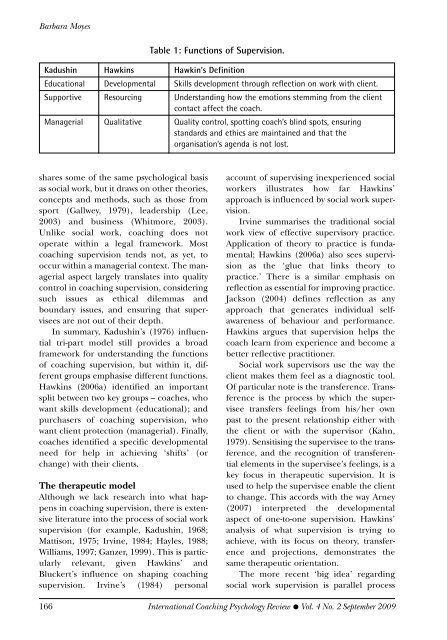International Coaching Psychology Review, 4.2, September 2009
International Coaching Psychology Review, 4.2, September 2009
International Coaching Psychology Review, 4.2, September 2009
You also want an ePaper? Increase the reach of your titles
YUMPU automatically turns print PDFs into web optimized ePapers that Google loves.
Barbara Moyes<br />
Table 1: Functions of Supervision.<br />
Kadushin Hawkins Hawkin’s Definition<br />
Educational Developmental Skills development through reflection on work with client.<br />
Supportive Resourcing Understanding how the emotions stemming from the client<br />
contact affect the coach.<br />
Managerial Qualitative Quality control, spotting coach’s blind spots, ensuring<br />
standards and ethics are maintained and that the<br />
organisation’s agenda is not lost.<br />
shares some of the same psychological basis<br />
as social work, but it draws on other theories,<br />
concepts and methods, such as those from<br />
sport (Gallwey, 1979), leadership (Lee,<br />
2003) and business (Whitmore, 2003).<br />
Unlike social work, coaching does not<br />
operate within a legal framework. Most<br />
coaching supervision tends not, as yet, to<br />
occur within a managerial context. The managerial<br />
aspect largely translates into quality<br />
control in coaching supervision, considering<br />
such issues as ethical dilemmas and<br />
boundary issues, and ensuring that supervisees<br />
are not out of their depth.<br />
In summary, Kadushin’s (1976) influential<br />
tri-part model still provides a broad<br />
framework for understanding the functions<br />
of coaching supervision, but within it, different<br />
groups emphasise different functions.<br />
Hawkins (2006a) identified an important<br />
split between two key groups – coaches, who<br />
want skills development (educational); and<br />
purchasers of coaching supervision, who<br />
want client protection (managerial). Finally,<br />
coaches identified a specific developmental<br />
need for help in achieving ‘shifts’ (or<br />
change) with their clients.<br />
The therapeutic model<br />
Although we lack research into what happens<br />
in coaching supervision, there is extensive<br />
literature into the process of social work<br />
supervision (for example, Kadushin, 1968;<br />
Mattison, 1975; Irvine, 1984; Hayles, 1988;<br />
Williams, 1997; Ganzer, 1999). This is particularly<br />
relevant, given Hawkins’ and<br />
Bluckert’s influence on shaping coaching<br />
supervision. Irvine’s (1984) personal<br />
account of supervising inexperienced social<br />
workers illustrates how far Hawkins’<br />
approach is influenced by social work supervision.<br />
Irvine summarises the traditional social<br />
work view of effective supervisory practice.<br />
Application of theory to practice is fundamental;<br />
Hawkins (2006a) also sees supervision<br />
as the ‘glue that links theory to<br />
practice.’ There is a similar emphasis on<br />
reflection as essential for improving practice.<br />
Jackson (2004) defines reflection as any<br />
approach that generates individual selfawareness<br />
of behaviour and performance.<br />
Hawkins argues that supervision helps the<br />
coach learn from experience and become a<br />
better reflective practitioner.<br />
Social work supervisors use the way the<br />
client makes them feel as a diagnostic tool.<br />
Of particular note is the transference. Transference<br />
is the process by which the supervisee<br />
transfers feelings from his/her own<br />
past to the present relationship either with<br />
the client or with the supervisor (Kahn,<br />
1979). Sensitising the supervisee to the transference,<br />
and the recognition of transferential<br />
elements in the supervisee’s feelings, is a<br />
key focus in therapeutic supervision. It is<br />
used to help the supervisee enable the client<br />
to change. This accords with the way Arney<br />
(2007) interpreted the developmental<br />
aspect of one-to-one supervision. Hawkins’<br />
analysis of what supervision is trying to<br />
achieve, with its focus on theory, transference<br />
and projections, demonstrates the<br />
same therapeutic orientation.<br />
The more recent ‘big idea’ regarding<br />
social work supervision is parallel process<br />
166 <strong>International</strong> <strong>Coaching</strong> <strong>Psychology</strong> <strong>Review</strong> ● Vol. 4 No. 2 <strong>September</strong> <strong>2009</strong>

















